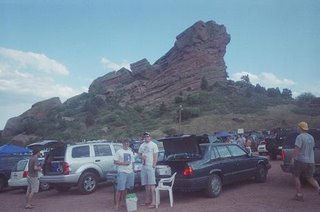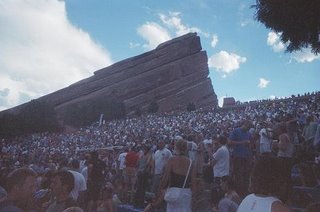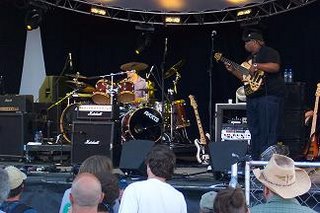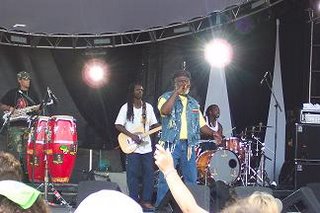The shows range in date from May to September and are rated as follows:
** - I want my money back.
*** - decent show.
**** - great show.
***** - amazing.
Pearl Jam – The Meadows Hartford, CT - 5/13/06
I believe the venue is now referred to as the New England Dodge Music Arena or some other new trite and capitalistic title. For me it has and will always be referred to as the meadows, ever since the first Phish show I saw there in the summer’ 00 that ended with an insane version of “While My Guitar Gently Weeps.”
It wouldn’t have been a PJ show without the rain and the mud, quickly turning the lawn into a would-be slip’n’slide Crocodile Mile style. They hit the ground running though, straight through the new self-entitled album Pearl Jam (2006) with “Severed Hand,” “World Wide Suicide,” “Life Wasted,” and “Marker In The Sand.” Overall it was a good show, sick version of “Better Man” in the first set with great crowd participation.
Betterman
Vedder also managed to make it through “Yellow Ledbetter” for an encore after downing a bottle of Merlot without falling off the stage, so that’s always good. Overall I give it *** ½ .
Tom Petty - The Tweeter Center Mansfield, MA - 6/21/06
Navigating to and from Mansfield and emerging from that labyrinth that is the Tweeter Center has always made me feel a bit like Lemmiwinks,
 and for some reason I never seem to be able to make it in from the parking lot to see the opener which was rather disappointing in this case since it happened to be Trey Anastasio. Tom Petty shows are always a good time but it’s just like listening to his greatest hits CD, going through everything from “Free Fallin’” to “Learning to Fly.” He did end with a nice version of “American Girl,” however the highlight of the show was definitely during “Last Dance With Mary Jane” when an altocumulus cloud of smoke rose from the crowd and almost blocked the view of the stage completely. Oh and I think Stevie Nicks was there. ***
and for some reason I never seem to be able to make it in from the parking lot to see the opener which was rather disappointing in this case since it happened to be Trey Anastasio. Tom Petty shows are always a good time but it’s just like listening to his greatest hits CD, going through everything from “Free Fallin’” to “Learning to Fly.” He did end with a nice version of “American Girl,” however the highlight of the show was definitely during “Last Dance With Mary Jane” when an altocumulus cloud of smoke rose from the crowd and almost blocked the view of the stage completely. Oh and I think Stevie Nicks was there. ***WSP - Red Rocks Morrison, CO - 6/23/06 – 6/25/06
These three shows were the highlight of the summer hands down. Red Rocks is by far the best venue I’ve ever been to, the acoustics, the scenery, the overall atmosphere is really amazing.
 The trip out to Denver overall was great, my only gripe was that it happened to fall during the World Cup, and waking up at 7:00 am to watch England’s match at The British Bulldog made for a rather long day.
The trip out to Denver overall was great, my only gripe was that it happened to fall during the World Cup, and waking up at 7:00 am to watch England’s match at The British Bulldog made for a rather long day.Panic wasted no time on Friday, ripping straight through “Pilgrims” with John Keane on guitar and a great version of “Junior” with the Dickinson brothers from The North Mississippi Allstars on guitar and percussion. They ended the first night with “Postcard” off of Everyday (1994), a great way to start to the weekend.
Saturday started off strong with “Thin Air” from Ball (2003), with a stellar version of “Aint Life Grand” to finish off the first set.
Aint Life Grand
Widespread opened the second set with an awesome version of the classic WAR tune, “Slipping in the Darkness” followed by an always popular “Chilly Water” and another excellent rendition of the timeless Talking Head’s “Life During Wartime.” I was actually lucky enough to be at the Garden in NY for Halloween 10/31/03 when they first covered this song.
 To this day that’s still the best show I’ve ever been to and there were actually a lot of first times that night, The Ramones “Beat on the Brat” and “I Wanna Be Sedated” just to name a few. Unfortunately they did end the second night with a bit of a buzzkill in “May Your Glass Be Filled” off the new album Earth to America (2006). The verdict is still out on their latest disc, I haven’t gotten a chance to really listen to it as much as I like but I plan to do a review shortly.
To this day that’s still the best show I’ve ever been to and there were actually a lot of first times that night, The Ramones “Beat on the Brat” and “I Wanna Be Sedated” just to name a few. Unfortunately they did end the second night with a bit of a buzzkill in “May Your Glass Be Filled” off the new album Earth to America (2006). The verdict is still out on their latest disc, I haven’t gotten a chance to really listen to it as much as I like but I plan to do a review shortly. So I went into the show on Sunday thinking there was strong possibility that it may turn out to be a bit of a lay-up for them, however the powerhouse trio of “Bear’s Gone Fishing,” “Coconut,” and “Travelin’ Light” in the first set made it pretty clear that wouldn’t be the case. Highlights of the second set included “Thought Sausage,” “Barstools and Dreamers,” and “Porch Song,” before they pulled out all the strings in the final encore of the weekend throwing down with “Low Spark,” into “Blue Indian” into “All Time Low.” Blue Indian off ‘Til The Medicine Takes (1999) was the best of the weekend in my opinion, I hadn’t heard the song live in six years since the 12/30/00 New Year’s show in Atlanta, GA, and they definitely did it justice.
So I went into the show on Sunday thinking there was strong possibility that it may turn out to be a bit of a lay-up for them, however the powerhouse trio of “Bear’s Gone Fishing,” “Coconut,” and “Travelin’ Light” in the first set made it pretty clear that wouldn’t be the case. Highlights of the second set included “Thought Sausage,” “Barstools and Dreamers,” and “Porch Song,” before they pulled out all the strings in the final encore of the weekend throwing down with “Low Spark,” into “Blue Indian” into “All Time Low.” Blue Indian off ‘Til The Medicine Takes (1999) was the best of the weekend in my opinion, I hadn’t heard the song live in six years since the 12/30/00 New Year’s show in Atlanta, GA, and they definitely did it justice.One last note, when the encore on Sunday ended and the weekend finally came to a close, there was no better song to choose for the PA music then “Burning Down the House.” No one left the show until the song had ended and I think this video illustrates just how much fun that 3 day weekend really was. *****
Burning Down the House
The Roots / Pharcyde / Talib Kweli – The Avalon Boston, MA - 8/7/06
I was actually rather lucky to even get tickets to this show, it sold out over two weeks in advance which is unusual for the Avalon, so craig’s list came up big on this one. Unfortunately I missed Pharcyde, it took me almost an hour to get into the venue with the line stretching all the way down Lansdowne St.. Once inside it was the typical Roots show: high energy songs with guest MC appearances by Kweli and others, typical impromptu ?uestlove drum solo, Black Thought controlling the mic, and Captain Kirk Douglas shreading guitar solos on “The Seed 2.0” from Phrenology (2002). The Philly-based group promoted the new album Game Theory (2006) well, giving the crowd a taste of “False Media” and “Game Theory” before their official release 8/29/06. I highly recommend picking up this disc as well as checking out The Roots on their fall tour. ****
MMW / Soulive – Long Island Jazz Festival Oyster Bay, NY - 8/12/06
First of all I don’t want to take anything away from either groups, both performances were excellent, I just didn’t feel like this was the best setting/location for them to perform to their fullest potential. Bands like Soulive in particular, whose funky high energy jams really feed off crowd participation, seemed somewhat out of place with the Tanglewood-esque wine and cheese party that was going on out in the lawn. Just to paint a brief mental image of the venue setup, there was a large tent over the stage with about 40 rows of folding chairs underneath. This extended out to a cement walkway dividing the tent from the lawn where the remainder of the crowd was sprawled out with blankets/chairs, cheese&crackers, and bottles of Robert Mondavi. Soulive actually succeeded in getting most of the people under the tent to rise out of their seats for the encore, most of the lawn folks had cleared out by the end of the first set of MMW. Here’s a link to the medeski martin and wood podcast. Both shows were excellent musically, MMW always impresses me with their ability to take a relatively simple idea (18:10 on the podcast) and expand on it, developing layers of sound that effortlessly intertwine and flow from one movement to the next. Chris Wood’s versatility on the electric as well as standup bass coupled with Billy Martin’s endless box of percussive gadgets and John Medeski’s virtuosic slapping of the ivory keys always make each show worth while. *** (easily 4 at a better venue)
VH1 We Are The 80s: Rick Springfield, Eddie Money, Loverboy and more – Bank of America Pavilion Boston, MA - 8/10/06
I got tickets for this show from the Verizon $10 for Tuesday special where they had a limited number of tickets for sale for $10 to a few shows around New England, still not an excuse I know. All I really remember was that my white headband really came in handy during “Turn Me Loose” by Loverboy, and thinking that in the end of the world after a nuclear holocaust Rick Springfield and the cockroaches will be the only one’s that survive. I also remember there being more cougars at the Pavilion that night than at the San Diego Zoo. Pretty sure I rode a rickshaw home. **
Johnny Lang – Cape Cod Melody Tent The Cape, MA - 8/11/06
I’m not really a huge fan of Johnny’s studio work (although it is pretty impressive his first album Smokin (1996) was released at age 14), however I must say his live performance was pretty outstanding. He really has become an authority on the blues scene, playing with an unrivaled intensity and burning through numerous guitar solos with a striking falsetto voice. I was also very impressed with the opening act Reve Carney, whose eloquent playing is very reminiscent of Nick Drake, Paul Simon, and the late Elliot Smith. Overall this was a good show at a very interesting venue with a rotating stage, which is always a good time. ***
Gathering of the Vibes - Mariaville, NY – 8/17/06-8/20/06
Well after weaving our way through the first field of the vibes and basically getting a body cavity search by the motor cycle gang that Terrapin hired as security detail, the tent was finally setup (in the dark nonetheless). The following three days of music saw headliners including: North Mississippi Allstars, Martin Sexton, Deep Banana Blackout, G-Love, Keller Williams, Bob Weir, Burning Spear, and Yonder Mountain String Band.
Friday began with a great show by set by The Scarecrow Collection, they actually covered a song called “Black Swan” by Thom Yorke off the The Eraser (2006). Next, North Mississippi kicked off the afternoon in style with a monster blues set. This is the fourth time I’ve seen them live and Luther’s swamp rock guitar licks coupled with Chris Chew’s dirty south bass continually make the bayou proud.
 The festival was off to a great start even in the mid-afternoon heat, as I began to sweat like Shack at the foul line. The evening brought some cooler weather and a solid set by Martin Sexton followed by the funkstravaganza that is Deep Banana Blackout.
The festival was off to a great start even in the mid-afternoon heat, as I began to sweat like Shack at the foul line. The evening brought some cooler weather and a solid set by Martin Sexton followed by the funkstravaganza that is Deep Banana Blackout.My Saturday afternoon was introduced in style by G-Love and the Special Sauce, providing the only real “hip hop” entertainment for the weekend. Jimmy-Jazz’s jams on that upright bass together with G-Love’s soulful harmonica banter really generate a unique and distinguished sound.
 The highlight of the weekend for me came Saturday afternoon when Keller Williams took the stage under ominous storm clouds. Keller threw down with a sick version of “Rainy Day” into “Dudley Wah” followed by the always popular “Freaker by the Speaker.” I’m not really sure what happened after “Breathe” but somehow with the help of ribcage-shaking bass from two towers of 30ft speakers he managed to start a rave in one of his trancey-endless loops that started somewhere before a trippy version of “Ninja” in the first set. I really felt like I was part of the dance party in Zion after Morpheus gives the speech about the machines coming in the third Matrix movie. He topped that off with an encore saw fantastic versions of “Dark Hollow” and “On the Road Again” with the man the myth the legend Bob Weir himself. Bob headlined with Ratdog Saturday night, representing Jerry well with great versions of “Jack Straw,” “Bird Song,” and the “Mississippi Half-Step” with Donna Jean Godchaux-Mackay.
The highlight of the weekend for me came Saturday afternoon when Keller Williams took the stage under ominous storm clouds. Keller threw down with a sick version of “Rainy Day” into “Dudley Wah” followed by the always popular “Freaker by the Speaker.” I’m not really sure what happened after “Breathe” but somehow with the help of ribcage-shaking bass from two towers of 30ft speakers he managed to start a rave in one of his trancey-endless loops that started somewhere before a trippy version of “Ninja” in the first set. I really felt like I was part of the dance party in Zion after Morpheus gives the speech about the machines coming in the third Matrix movie. He topped that off with an encore saw fantastic versions of “Dark Hollow” and “On the Road Again” with the man the myth the legend Bob Weir himself. Bob headlined with Ratdog Saturday night, representing Jerry well with great versions of “Jack Straw,” “Bird Song,” and the “Mississippi Half-Step” with Donna Jean Godchaux-Mackay.So after the ensuing torrential downpour and hurricane-like conditions we survived on Saturday night, I woke up on the air mattress (roughing it I know) which actually doubled as a raft that night, drained the water out of my tent, and headed to the main stage to see Burning Spear.
 After reciting all of the countries of the world and whishing for peace in each of them, Rodney and the gang finally took the stage and broke into a stellar version of “Door Peep.” Other highlights of the set included “Jah Is My Driver” and a great version of the timeless classic “Marcus Garvey.” They ended the show in style with a fantastic version of the always groovy “African Postman” off This World Should Know (1993). Long Live Dub.
After reciting all of the countries of the world and whishing for peace in each of them, Rodney and the gang finally took the stage and broke into a stellar version of “Door Peep.” Other highlights of the set included “Jah Is My Driver” and a great version of the timeless classic “Marcus Garvey.” They ended the show in style with a fantastic version of the always groovy “African Postman” off This World Should Know (1993). Long Live Dub.After the spear we returned to the campsite and I made a game time decision to leave before Younder Mountain that afternoon.
 The road situation was quickly deteriorating and it just wouldn’t have been a festival if my car didn’t start so rather than risk it losing the charge again and getting trapped in there any worse, we took off mid day Sunday. Overall it was a great Vibes, again Terrapin could have been a bit more selective in there crew hiring process and not packed us into the site like sardines in a crushed tin box, but given the choice I would definitely do it again. ****
The road situation was quickly deteriorating and it just wouldn’t have been a festival if my car didn’t start so rather than risk it losing the charge again and getting trapped in there any worse, we took off mid day Sunday. Overall it was a great Vibes, again Terrapin could have been a bit more selective in there crew hiring process and not packed us into the site like sardines in a crushed tin box, but given the choice I would definitely do it again. ****Steve Miller – Bank of America Pavilion - 8/25/06
The Steve Miller Band put on a decent run-of –the-mill greatest hits show with radio staples like "Take the Money and Run,” “Jet Airliner,” “Pompitous of Love,” etc… I was hoping for some deep cuts like “Quicksilver Girl” or something like that but Steve decided to go with the hits that night. Another $10 Tuesday special, decent show but not sure if I would return. ***
Allman Bros / Gov’t Mule Tweeter Center Mansfield, MA– 8/26/06
Warren Haynes, Derek Trucks, and Gregg Allman all on stage what more could a girl want? On a more serious note though, three gentlemen who absolutely slay the axe playing at the same time, you would think one would stand out more than the others and usually that would be Mr. Trucks, however on this fateful night Warren was not to be outdone. Haynes and Trucks dueled through stellar renditions of “It’s Not My Cross to Bear,” “Statesboro Blues,” “Midnight Rider,” “Melissa,” and “In Memory of Elizabeth Reed,” before finally calling a truce after an unbelievable “Whipping Post” encore. Seriously though Duane would be proud. ****
Steely Dan – Tweeter Center Mansfield, MA - 8/27/06
This was simply an outstanding concert, Donald Fagan and Walter Becker are two of the best musicians I’ve ever had the privilege to see live, and they certainly put on a great show that evening. Notice how I didn’t mention Michael McDonald. We struggled through his uneventful set prior to seeing the Dan, but in case you missed it just walk into the electronics department of your local Circuit City and it’s just like you were there! I suppose his set was bearable once you got over the pretentious piano placement right in the front center of the stage, but Steely Dan really stole the show playing virtually everything off ShowBiz Kids (2000). ****
The Flaming Lips – Bank of America Pavilion Boston, MA - 9/10/06
Flaming Lips shows are always a great time, basically a giant party from start to finish. After questioning your sanity and deciding that yes, there are actually girls dressed in purple teddies with green alien masks dancing on one side of the stage opposite girls dressed as Santa Claus waiving flashlights on the other, and that yes, that really was a boxing nun that sang “Yoshimi Battles the Pink Robots,” you begin to realize that maybe the giant balloons and clouds of confetti bombarding you in the crowd really are necessary components of the show. Great versions of “The Spoonful Ways a Ton,” off The Soft Bulletin (1999), and “The Yeah Yeah Yeah Song,” “Free Radicals,” and “W.A.N.D,” off the new album At War with the Mystics (2006), at times seemed to be only side notes given the atmosphere and the energy Wayne Coyne and the gang were able to create. On a side note Wayne did say that Steven Drozd was the only musician he knew who actually had to pause the show for a few minutes to empty the confetti from his keyboard. This was the best show I’ve seen thus far at the Pavilion. *****
Do You Realize?




